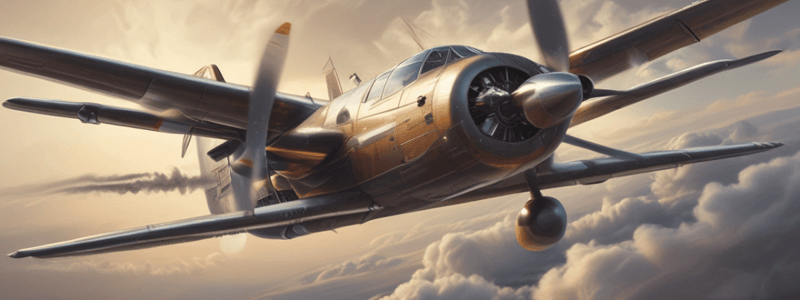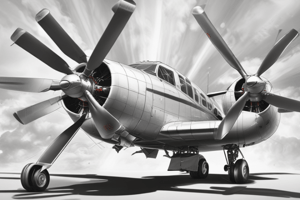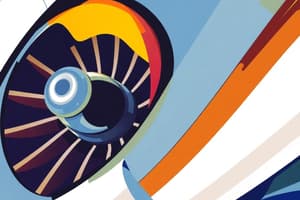Podcast
Questions and Answers
What is the primary reason why pilots need to adjust propeller pitch angle during flight?
What is the primary reason why pilots need to adjust propeller pitch angle during flight?
- To reduce fuel consumption during cruising altitude
- To adapt to changing flight conditions and optimize thrust production (correct)
- To increase payload capacity during takeoff
- To minimize noise levels
What type of engine is typically used on aircraft that require high efficiency at lower speeds and altitudes?
What type of engine is typically used on aircraft that require high efficiency at lower speeds and altitudes?
- Jet engine
- Turboprop engine (correct)
- Piston engine
- Diesel engine
What is the primary consequence of poor propeller performance?
What is the primary consequence of poor propeller performance?
- Reduced safety margins
- Increased fuel consumption
- Decreased payload capacity
- All of the above (correct)
What is critical to ensure correct propeller function and identify potential issues?
What is critical to ensure correct propeller function and identify potential issues?
What aspect of propeller design is influenced by the number of blades?
What aspect of propeller design is influenced by the number of blades?
What is the primary impact of propeller efficiency on aircraft operation?
What is the primary impact of propeller efficiency on aircraft operation?
What is the typical use of piston engines in aircraft?
What is the typical use of piston engines in aircraft?
What is the expected outcome of advances in propeller design technology?
What is the expected outcome of advances in propeller design technology?
What is the primary factor that affects the efficiency of thrust production in a propeller?
What is the primary factor that affects the efficiency of thrust production in a propeller?
What is the significance of understanding propeller performance in aircraft operation?
What is the significance of understanding propeller performance in aircraft operation?
A propeller's blade shape affects only its ability to avoid aerodynamic phenomena at high speeds.
A propeller's blade shape affects only its ability to avoid aerodynamic phenomena at high speeds.
A higher pitch angle is always more fuel-efficient during flight.
A higher pitch angle is always more fuel-efficient during flight.
Turboprop engines are typically used on smaller general aviation aircraft.
Turboprop engines are typically used on smaller general aviation aircraft.
Propeller performance has a direct impact on an aircraft's range and payload capacity.
Propeller performance has a direct impact on an aircraft's range and payload capacity.
Regular maintenance is only necessary to identify issues with propeller performance.
Regular maintenance is only necessary to identify issues with propeller performance.
Piston engines are designed to drive complex propeller designs.
Piston engines are designed to drive complex propeller designs.
The primary benefit of optimizing propeller performance is increased safety margins.
The primary benefit of optimizing propeller performance is increased safety margins.
A propeller's diameter affects its noise levels during flight.
A propeller's diameter affects its noise levels during flight.
The interplay between engine type and propeller performance is insignificant for aircraft operation.
The interplay between engine type and propeller performance is insignificant for aircraft operation.
Understanding propeller performance is only important for pilots of commercial aircraft.
Understanding propeller performance is only important for pilots of commercial aircraft.
How do the design aspects of a propeller, such as the number of blades and blade shape, influence its performance?
How do the design aspects of a propeller, such as the number of blades and blade shape, influence its performance?
What is the significance of the interplay between engine type and propeller performance in aircraft operation?
What is the significance of the interplay between engine type and propeller performance in aircraft operation?
How do operational factors, such as blade pitch angle, impact propeller performance during different phases of flight?
How do operational factors, such as blade pitch angle, impact propeller performance during different phases of flight?
What are the consequences of neglecting regular inspection and maintenance of propellers?
What are the consequences of neglecting regular inspection and maintenance of propellers?
How does propeller efficiency impact the overall performance of an aircraft?
How does propeller efficiency impact the overall performance of an aircraft?
What is the relationship between propeller design and the aerodynamic phenomena it encounters during high-speed operations?
What is the relationship between propeller design and the aerodynamic phenomena it encounters during high-speed operations?
How do pilots optimize propeller performance to achieve a safe and efficient journey?
How do pilots optimize propeller performance to achieve a safe and efficient journey?
What is the significance of turboprop engines in aircraft operation, and how do they differ from piston engines?
What is the significance of turboprop engines in aircraft operation, and how do they differ from piston engines?
What is the expected impact of advances in propeller design technology on future aircraft capabilities?
What is the expected impact of advances in propeller design technology on future aircraft capabilities?
How does propeller performance influence the overall safety of an aircraft operation?
How does propeller performance influence the overall safety of an aircraft operation?
Flashcards are hidden until you start studying
Study Notes
Propeller Performance
- Propellers serve as the workhorse for many aircraft, translating engine power into thrust that propels an airplane forward.
- Propeller design is critical, with factors like blade shape, size, and pitch influencing thrust and efficiency.
- The efficiency and thrust of a propeller are influenced by multiple factors, including:
- Angle of attack of each blade during rotation
- Material used to make the propeller (e.g., aluminum, composites)
- Propeller pitch, which dictates how aggressively a propeller bites into the air
Types of Propellers
- Fixed-pitch propellers: blades fixed at a specific angle
- Variable-pitch propellers: allow the pitch (angle of the blades) to be altered during flight to optimize performance
- Constant-speed propellers: a type of variable-pitch propeller that automatically adjusts to maintain a constant RPM, optimizing efficiency across various flight conditions
Propeller Performance Factors
- Angle of propeller blades: affects thrust output, with higher angles producing more thrust but requiring more engine power
- Air density: decreases with altitude, affecting propeller efficiency
- Temperature: colder air is denser, increasing thrust output, while hot air decreases propeller efficiency
- Speed of propeller (RPM): directly affects thrust production, with high RPM risking engine and propeller wear, and low RPM resulting in insufficient thrust
- Condition of the propeller: damage, nicks, and dents can lead to inefficiencies and hazardous vibrations
- Aircraft weight and balance: affects the load experienced by the propeller, with overloaded or imbalanced aircraft putting excessive stress on the propeller
- Conversion of engine power to usable thrust: requires careful coordination between engine output and propeller efficiency
Importance of Propeller Performance
- Critical for pilots to understand to identify the ideal propeller type for specific flight conditions and aircraft
- Affects fuel consumption, range, and payload capacity
- Poor propeller performance can lead to increased operational costs and reduced safety margins
Propeller Performance
- Propellers serve as the workhorse for many aircraft, translating engine power into thrust that propels an airplane forward.
- Propeller design is critical to an aircraft's performance, with factors such as blade shape, size, and pitch influencing thrust and efficiency.
Propeller Types
- Fixed-pitch propellers: blades fixed at a specific angle, with pros and cons depending on the mission and aircraft type.
- Adjustable-pitch propellers: allow the pitch to be altered during flight to optimize performance.
- Constant-speed propellers: automatically adjust to maintain a constant RPM, optimizing efficiency across various flight conditions.
Propeller Performance Factors
- Angle of attack of each blade during rotation: affects thrust and efficiency.
- Material from which the propeller is made: affects strength, weight, and corrosion resistance.
- Propeller pitch: a variable that dictates how aggressively a propeller bites into the air, similar to shifting gears on a bicycle.
- Air density: decreases with altitude, affecting propeller efficiency.
- Temperature: colder air is denser, increasing thrust output, while hot air decreases propeller efficiency.
- Speed of the propeller (RPM): directly affects the amount of thrust produced, with too high or too low RPM affecting engine and propeller wear.
- Condition of the propeller: damage, nicks, and dents can lead to inefficiencies and potentially hazardous vibrations.
- Aircraft weight and balance: affects the load experienced by the propeller, influencing performance.
Design and Operational Considerations
- Number of blades: affects thrust production, noise levels, and aerodynamic phenomena.
- Blade shape and pitch: influence efficiency, noise levels, and aerodynamic phenomena.
- Propeller diameter: affects thrust production and efficiency.
- Speed at which the propeller rotates: affects thrust production and efficiency.
- Operational factors: such as takeoff and cruising altitude, require adjustments to propeller settings to adapt to changing flight conditions.
- Interplay between engine type and propeller performance: turboprop engines designed for high efficiency at lower speeds and altitudes, while piston engines suited for low-speed operations.
Importance of Propeller Performance
- Affects fuel consumption, range, and payload capacity.
- Poor propeller performance can lead to increased operational costs and reduced safety margins.
- Regular inspection and maintenance are crucial to ensure propellers function correctly and identify issues that can degrade performance.
Propeller Performance and Aircraft Maneuverability
- Propeller performance is crucial for aircraft maneuverability, efficiency, and safety.
- The right propeller design and maintenance can significantly uplift aircraft performance and efficiency.
Types of Propellers
- Fixed-pitch propellers: blades fixed at a specific angle, simple and economical, but may not be efficient across various conditions.
- Variable-pitch propellers: can change blade angle in flight, optimizing performance for different phases of flight.
- Constant-speed propellers: automatically adjust to maintain a set engine RPM, optimizing efficiency across various flight conditions.
Factors Affecting Propeller Performance
- Pitch angle: higher angle produces more thrust but requires more engine power.
- Air density: decreases with altitude, affecting propeller efficiency.
- Temperature: colder air is denser, increasing thrust output, while hot air decreases propeller efficiency.
- RPM: directly affects thrust produced, with too high RPM risking engine and propeller wear, and too low RPM not producing enough thrust.
- Propeller condition: damage or wear can lead to inefficiencies and hazardous vibrations.
- Aircraft weight and balance: affects the load experienced by the propeller, with overloaded or imbalanced aircraft stressing the propeller.
- Propeller efficiency: directly affects fuel consumption, range, and payload capacity.
Propeller Design and Operation
- Propellers convert engine power into thrust, moving the aircraft through the air.
- Design and operation involve aerodynamics, material science, and mechanical engineering.
- Propeller characteristics influence thrust production, noise levels, and ability to avoid aerodynamic phenomena.
Importance of Propeller Performance
- Understanding propeller performance is key to comprehending aircraft design and operation.
- Poor propeller performance can lead to increased operational costs and reduced safety margins.
- Regular inspection and maintenance are crucial to ensure propellers function correctly and identify issues.
Studying That Suits You
Use AI to generate personalized quizzes and flashcards to suit your learning preferences.




